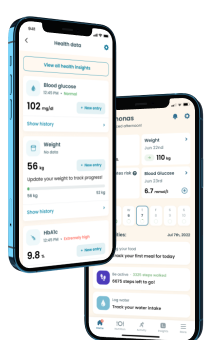Diabetic Neuropathy: Symptoms, Causes, and Treatment

Prolonged exposure to high blood sugar levels and high levels of fats for people with diabetes may lead to a serious nerve damage disorder called diabetic neuropathy. Although it is definitely preventable, not properly taking care of your condition and lifestyle can lead to irreversible damage.
Diabetic neuropathy is specific in the sense that it can differ due to the affected body part. It’s quite dangerous for people with type 1 or type 2 diabetes because each nerve damage has different symptoms and can seem hidden until it’s too late.
In this article, we’ll look at the 4 types and symptoms of this nerve disorder and discuss the possible options of how to avoid it.
Peripheral Neuropathy
Typically damaging the feet and legs, peripheral neuropathy is the most common nerve damage type, with almost 50% of people with diabetes affected. Its symptoms include:
- Pain or burning sensation
- Cramps
- Tingling or numbness
- Loss of sensation
- Greater sensitivity to touch
- Weakness
- Unsteadiness
- Hot or cold feelings in the feet and legs
- Joint and bone pain
- Sores and ulcers in the feet and toes
In rarer cases, this type can affect the arms or hands and is dangerous as you might not feel pain or sores straight away. It’s essential for people with especially low blood circulation to periodically visit their health care provider for a medical check-up.
Proximal Neuropathy
The pain and sensations in the mid-region, upper legs and thighs, buttocks, abdomen, lower back, and even chest are signs of proximal neuropathy. Although much less common than peripheral neuropathy, this type can cause severe pain, affects only one side of the body, and can make it difficult to even stand up. The most typical symptoms are:
- Pain in hips, thighs, buttocks
- Weakness in thighs and legs
- Pain occurring when you stand up
- Loss of reflexes
- Muscle wasting, more so in the thighs and legs
- Weight loss
Fortunately, this type is usually treatable and, in some cases, can disappear after a few years.
Autonomic Neuropathy
This nerve damage type affects the function of your internal organs. It’s especially dangerous as people with autonomic neuropathy might not notice that their blood glucose levels are low, resulting in hypoglycemia. Depending on which organs are affected, you can experience these symptoms:
- Dizziness
- Fainting
- Sexual dysfunction
- Bladder or urinary infections
- Digestive problems like bloating, vomiting, heartburn, poor digestion
- Vision problems
- A heart rate that does not increase with activity
- Excessive sweating or no sweating
Focal Neuropathy
Focal neuropathy is also known as mononeuropathy. Unlike other types, this one is limited to only single nerves. As it affects only one part of the body, you should be on the lookout for symptoms like:
- Vision disturbance or double vision
- Pain behind one eye
- Face paralysis on one side
- Hand weakness, making holding things difficult
- Frequent tripping
- Hearing problems
- Chest, stomach, lower back, pelvis, or flank pain
Why Does Diabetic Neuropathy Occur?
As it is a progressive disease, its symptoms only worsen with time. Initially, when you are diagnosed with diabetes, you are probably more vigilant and keep your sugar levels under control. As time passes, you may not even be aware that your sugar levels are constantly high unless you monitor them regularly, depending on your diabetes type.
High blood sugar levels can disturb the oxygen and nutrient supply into your nerves, and over several years, this can damage the nerves slowly and steadily.



As many as 70% of people with diabetes may suffer from diabetic neuropathy over the course of managing the disease for more than 10 years.
What Are the Stages of Diabetes Neuropathy?
It’s vital that you familiarize yourself with the initial signs and symptoms of neuropathy so that you can get the required treatment. In the early stages, it may be possible to reverse the damage or at least put an end to the progression.
Here are the 5 stages you should be aware of that will help differentiate when you actually need to seek medical attention:
- Stage one – you may feel occasional numbness or pain in your feet or legs, a slowing of reflexes, or other problems. As this may occur once in a while, you may not even relate it to diabetes. You may go for weeks or months without any symptoms.
- Stage two – when the sensations become more constant, and you realize something is off, by then you are in stage two. If you still ignore the symptoms, you are likely to face irreversible damage.
- Stage three – when the pain increases and you experience many symptoms together, you really need medical advice if you have ignored the signs. Constant pain, numbness, loss of sensation, poor wound healing, frequent infections are all signs of diabetic neuropathy.
- Stage four – if you feel a constant loss of sensation and more numbness but very little pain, you are in this stage. This is dangerous and shows that your nerves are damaged, probably beyond repair. You may have already suffered some organ damage.
- Stage five – when you have lost feeling in your legs and feet, when you find it difficult to walk and require a wheelchair, perhaps, you are in this stage. By this time, it will be impossible to reverse any damage, and you may even need amputation if your nerves are badly affected.
How Fast Does Diabetic Neuropathy Progress?
This complication of diabetes can take place over several years before you notice any symptoms. As much as 50–70% of people with diabetes may develop different kinds of neuropathies from between 10–20 years after diagnosis.
People with type 1 diabetes are at 20% risk of developing neuropathy after 20 years. This is possibly because they have to monitor their blood sugar more closely and balance it with the insulin injections. Those with type 2 diabetes, however, are at 50% risk of developing diabetic neuropathy after 7–10 years or earlier.
What is more surprising, and you need to be aware of this, is that even if you have not been diagnosed with any form of diabetes, you can still suffer from diabetic neuropathy if you just have pre-diabetes. In this case, the damage can also take place over months or years.
The earlier the damage is diagnosed, the greater the chances of controlling or even reversing the harm.
What Are the Treatment Options of Diabetic Neuropathy?
There are many treatment options, depending on the stage of neuropathy and where it occurs. Many are directed at the particular part of the body or organ that it affects. Your doctor usually suggests a multidisciplinary approach and may give you:
- Anti-depressants for nerve pain
- Analgesics for pain
- Bladder training for urinary problems or antibiotics for infections
- Medicine to treat erectile dysfunction in men
- Lubricants or hormonal creams for women with vaginal dryness
- Various types of medicine or a change in diet for digestive issues
- Hot and cold patches or treatment such as baths or soaks
- Topical application of creams, lotions, gels for pain relief
- Compression stockings for dizziness or hypotension
- Physical therapy and stretching exercises to relieve pain and strengthen muscles
- Medicine for high blood pressure, if that is an issue
Most of these offer symptomatic relief. It is important to manage the problems and the pain and prevent them from worsening.
Measures to Prevent It
As there is no known cure for diabetic neuropathy, it is best that you adopt all the measures to prevent it. Some important steps to take:
- Keep sugar levels under control.
- Monitor your sugar levels regularly and adjust insulin or medicine dosage.
- Lose weight if required.
- Get in some exercise regularly.
- Make dietary changes, eating more whole foods, fruit, vegetables, and include some white meat and fish in your diet, reducing your dependency on red meat and processed foods.
- Don’t smoke.
- If you have high blood pressure, make sure to keep it under control
You can also try alternative remedies like acupuncture, natural supplements, and herbal remedies after checking with your doctor. Do take conventional remedies and change your diabetic medicines if called for. And always be aware of the symptoms of diabetic neuropathy.
Key takeaways:
- Diabetic neuropathy is not inevitable – if it is caught early enough, it can be manageable as long as you ensure that your sugar levels are under control.
- Even occasionally, feeling “off” can be a sign of neuropathy – in the initial stages, you may feel some pain or numbness or poor reflexes or loss of balance once in a while. One or more symptoms signal the start of neuropathy.
- Keeping your sugar levels at bay is crucial – higher than normal blood sugar levels can damage organs and nerves.
- Diabetic neuropathy is largely irreversible – symptoms can be managed with various treatments, and the damage controlled or reversed.
Take a quiz and get your diabetes-management plan today!









